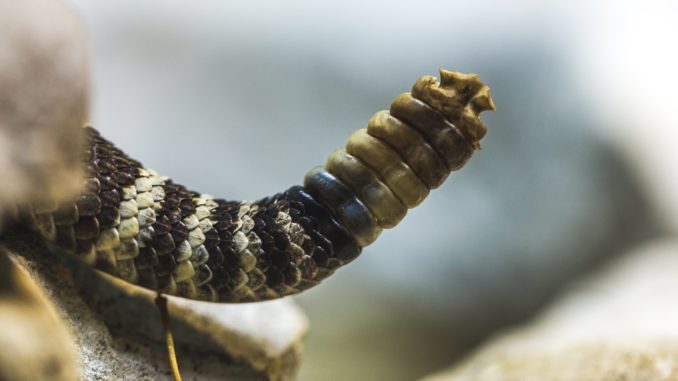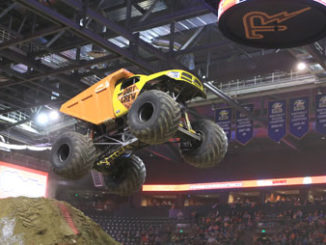
By Peter Moore
MY NEIGHBOR AND I WERE HAVING A NICE HIKE on Horsetooth Rock.
Then suddenly, John was running toward me on the trail, dragging his dog behind him, yelling “Oh sh*t oh sh*t OH SH*T!”
Actually, he had prepared for this behavior.
On our way up the trail, John and I had been discussing his feelings toward snakes. I.E., his loathing, his terror, his determination to avoid them like the plague. Or like an injection of venom directly into his shin.
John is a very sensible fellow.
He and his dog Russell had been leading our party earlier that morning, and I shared some wisdom I’d heard from another hiking buddy, just a few days earlier: “It’s the second guy in the line who gets bit,” my friend turned around to tell me, accelerating to maintain his place at the head of the line.
Depending on whether you counted Russell as a “guy,” I was either the second or third hiker in our little troop on Horsetooth. So I’d either get bit, or have to call in the rescue chopper. (But not bite and suck; see box below.) Rattlesnakes and their babies are just emerging from their dens now, and according to Ty Petersburg, area wildlife manager for Colorado Parks and Wildlife, it’s the little ones that get you. “The young ones don’t know how to manage their venom,” he told me. “So they give you the full shot.”
In fact, the first half of the hike was in fact uneventful—at least, in a snakey way.
After taking in glorious views of Long’s Peak, Mount Meeker, and the Continental Divide from the rocky top—and after John and Russell ate half of my snacks, having forgotten theirs in the car—we chose the narrow, rocky Audra Culver trail (snake habitat) for our descent.
The route reminded me of a hike my wife and I had taken in Eldorado Canyon State Park, just south of Boulder. We headed up the Rattlesnake Gulch Trail one hundred yards, where our progress was impeded, yes, by a four-foot long rattlesnake sunning him/herself in the middle of the trail.
I don’t think so. About face!
Ty Petersburg’s advice on that: A sunning, stretched out snake can’t leap at your leg as easily. A coiled snake, however, is poised for a spring. Let the hiker beware.
On our hike, I was following John down the Audra Culver Trail, until as noted, he ran screaming past me, dragging Russell behind him. I peered ahead to investigate why he’d thrown our entourage into reverse.
And there it was: a diamond-patterned brown and yellow snake body, extending a scaly tail into the hiking path. I inched forward for a better look. And listen.
All quiet, i.e., no rattling whatsoever.
A few steps further: a lovely, harmless, pointed tail, with no rattles whatsoever.
Ah. Bullsnake.
The same guy who’d shared the wisdom about bite probabilities had also enlightened me on the differences between the scary rattler and the benign bull: a happy ending to its body, rather than a threatening one.
I walked back up the trail to explain all this to John, whose pulse rate seemed to have steadied. I could no longer see the whites of his eyes. I showed him the picture I’d snapped of a very long (four feet, and I couldn’t even see his head), very thick, very well-ornamented bull snake.
We agreed to cautiously proceed in the direction we’d chosen before nearly tripping over the bull snake. It had vanished into the underbrush.
Which underscores an important point: Sometimes the scariest snake is the one you can’t see.
With adrenalized awareness of every footfall, of each flicker in the underbrush, we completed a hyper-vigilant hike back to the trailhead.
And for that, I say: Thank you bull snake, and even your terrifying lookalikes the rattlesnakes. You reminded me that in nature, the zen practice of heightened awareness can be another form of enjoyment.
RATTLER BASICS
- According to the CSU Extension Service, the western rattlesnake (Crotalus viridis) is the only venomous snake in northern Colorado. It’s identifiable by its rattles, by its triangular head and narrow neck, and if you get close enough to see (advice: don’t!), the scary-as-hell slit-like, elliptical pupils of its creepy little snake eyes.
- Snake habitat is everywhere, especially along the Audra Culver Trail on Horsetooth. Note to friend John: “If you are confronted with a rattlesnake, remain calm and still at first, then try to back away slowly and carefully.”
- Also noted: “The most useful snakebite first aid kit,” says the Extension Service, “is car keys and a phone for calling the hospital.”
- If you or a companion are bitten, no sucking out the poison! That only works because—happy news!—most rattlesnake bites aren’t fatal.
Last really terrifying thing to know, according to CSU’s snakeologists: Even if you cut a rattler’s head off, it can still bite you! Steer clear, OK?
Support Northern Colorado Journalism
Show your support for North Forty News by helping us produce more content. It's a kind and simple gesture that will help us continue to bring more content to you.
BONUS - Donors get a link in their receipt to sign up for our once-per-week instant text messaging alert. Get your e-copy of North Forty News the moment it is released!
Click to Donate



